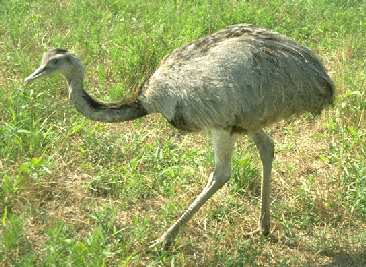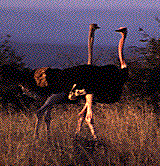Introduction to the Palaeognathae
Mostly flightless


The Palaeognathae includes the largest of all living birds, the ostrich, which can reach three meters (9 ft) and 135 kilograms (300 lbs). Many palaeognaths are quite large birds, relying on running speed and vicious kicking to defend themselves -- the fastest living bipedal runner, an ostrich can outrun a horse and kill a human with a single kick. But other paleognaths, like the three spacies of kiwi (Apteryx) living on New Zealand, are small, shy, retiring creatures.
 Palaeognath birds are grouped together on the basis of their distinctive
palate morphology, from which they receive their name ("old jaw").
Most of the birds classified in the Palaeognathae are also flightless,
but not all flightless birds are classified in the Palaeognathae. Some
flightless birds, such as living penguins, puffins, and rails, and the
extinct auks and phororhacoids, are classified in the
Neognathae
along with most flying birds. Furthermore, some early
Cenozoic birds
had a typical palaeognath palate but a strongly keeled sternum, suggesting that
they could fly well. It seems most likely that palaeognaths evolved from flying
ancestors.
Palaeognath birds are grouped together on the basis of their distinctive
palate morphology, from which they receive their name ("old jaw").
Most of the birds classified in the Palaeognathae are also flightless,
but not all flightless birds are classified in the Palaeognathae. Some
flightless birds, such as living penguins, puffins, and rails, and the
extinct auks and phororhacoids, are classified in the
Neognathae
along with most flying birds. Furthermore, some early
Cenozoic birds
had a typical palaeognath palate but a strongly keeled sternum, suggesting that
they could fly well. It seems most likely that palaeognaths evolved from flying
ancestors.
Palaeognath birds are now classified into two groups: the Tinamiformes, which include the tinamous of South and Central America; and the Ratitae, or ratite birds. Tinamous have a keeled sternum and can fly (weakly), while ratites have flat sterna and reduced wings, and cannot fly at all. Living ratites include the African ostrich (shown at right); the rhea of South America (pictured above); the Australian emu and New Guinea cassowary; and the kiwi of New Zealand. Other ratites, the elephant bird of Madagascar and the moas of New Zealand, have been extinct for several centuries, probably as a result of human hunting.
The Ratite Home Page provides much information and links concerning living ratites.
You can also read about kiwis (and kiwifruits, too, while you're at it).


